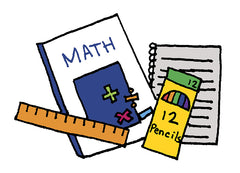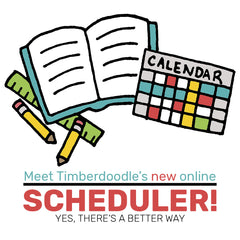We are often asked how our curriculum will work for a child with autism. This is a subject near and dear to our hearts, as you’ll hear in the video.
A HELPFUL OVERVIEW
Today we are going to discuss using Timberdoodle curriculum with your child with autism. While this is just a quick overview of a couple highlighted topics pertaining to working with children with autism, we know that every child with autism is unique and each one is gifted and challenged in unique ways, and they do not often fit into an easy generalization. Yet we still wanted to spark your imagination on how to use some of these products with your child, and hopefully point you in some helpful directions. We hope you enjoy this discussion.
Deb: Today we’re going to look at the question of how Timberdoodle’s curriculum works with children with autism.
Our experience with autism goes back a number of years. We have a good family friend who had a daughter who was eight. They were looking for respite care for her. She has severe autism. She came and lived with us for approximately a year. We started off by trying to get some basic language skills. She had very little. She couldn’t even say no or yes to request from our family if she wanted more orange juice or whatever. Tell us how we did that, Hope.
Hope: Basically, we found it was, in essence, really intensive parenting. We worked through an ABA therapy course that trained us how to train her. But when we boiled it all down, we really felt like essentially, this is very intensive parenting.
Deb: Exactly. I was looking at what you guys were doing, because you were the primary teachers of Krissy, and I was saying, “Yeah, that’s how I worked with you,” but it was a lot more intense, lots more repetitions. So that was one of the insights that we got from this whole thing. The other was there are two problem areas that children with autism face. What are they?
Hope: One that we noticed for Krissy was the auditory processing. You could be talking to her and if she could focus on what you were saying she would be able to understand it, breaking through, so that she could auditorily process what was going on. That was really difficult for her.
VIDEO CLIP OF HOPE WORKING WITH KRISSY.
Hope: Krissy, I have something that you wear on your head. Do you have something that you wear on your head? (Waits. Touches Krissy.) Do you have something that you wear on your head?
Krissy responds and chooses appropriate picture.
Hope: There it is! Good job!
Deb: Another thing that we noticed, particularly with children at the high-functioning end of the autism spectrum, was opinions are very difficult for them. So if you were to say to them, “What is your favorite ice cream?” they ulcerated over that and they couldn’t decide. Generalizations were very hard for them to make. They couldn’t get simple jokes.
Hope: If it was factual they thrived. If it wasn’t facts, if it was, “What would you suppose?” or, “What could happen?” or, “What do you think about…?” that was harder for them to be able to answer.
Deb: Now let’s come back to the question, “Will Timberdoodle’s curriculum work with those children?” and the simple answer is, “Yes and no.” Yes, for all the factual things. The math, they’re going to thrive on that. That’s a no-brainer. The reading, again, it’s going to follow a pattern that’s going to be familiar to them. There will be problem areas, particularly as they get into the higher reading programs, such as Mosdos, where they’re going to have to infer some things or speculate, and that’s going to be very difficult for them. Do you not then use that?
Hope: No, you do. If you have a child with autism you will be best served by contacting us and saying, “Here’s what my specifics are,” because it’s going to depend a lot on their age and their skills. For Krissy, working through the Building Thinking Skills books, we would get stuck with things like, “Which one is behind?” or, “Which one is under?”

Deb: If you have a child like that, then Bunny Peek-a-Boo works for them, regardless of the age, because Bunny Peek-a-Boo is going to work on those ideas of put the bunny inside or put it behind or put it on top. It’s going to work with those. So knowing where your child is at will help us help you put together a curriculum that will work for them.
Hope: And once they have those skills, then ultimately they’ll be able to use the Beginning Thinking Skills, and then Critical Thinking Skills and so on. Those books will still be the foundation for which you will grow, but you may have to take the skills that they are working on in there and spend some extra time outside of it, using some of the other resources to drill this into them.
Deb: Those books will flag to you, “This is a problem! What do I do about that?” We can help you try to formulate an idea.
The other problem area is going to be addressed in our doodle books. It can be addressed in a number of different ways, but our doodle books provide a great way for them to practice thinking skills. “What is the man pushing?” Now they’ve got to think about, what does that mean to push something? What is it? It’s going to be hard for them to do that. Does that mean you don’t do the things that are hard? No, we think you do, but you try to gauge it to their age. So if this is going to be difficult, don’t give them an 8th grade doodle book. Dial it back to something that is more user-friendly for them. It’s just a matter of knowing your child, knowing their strengths and their weaknesses, and keeping them on that trajectory for typical learning.
Hope: Yes, and so back to, will Timberdoodle curriculum work? Yes. You probably will want to pare it down to the essentials. You don’t want to get bogged down trying to get through everything.
We also focus really highly on the emotional intelligence. In the world of autism, this is a huge deal. It’s a huge deal in a typically functioning child, but in the world of autism we’re going to need to be more intentional about it. Resources that we have like the Stages Emotions cards are ideal in the world of autism.

Deb: Exactly. It will show you a card of a situation and you’re going to ask your child, “What is the man feeling? What is the woman feeling? Why are they feeling that way? What is going on in this picture?” They’re going to have to use their thinking to get to there and I think the more practice they have the easier it will be. Will it be difficult for him? Yes. It’s going to stretch them, but there is going to be stretching in a way that’s going to give them the skills that they will need to progress through their schooling.
Hope: With a typically functioning child you may be able to start with “What’s this person feeling and why?” For the child with autism you’re going to start out with maybe just labeling it. “Show me the one that’s sad, show me the one that’s disappointed.” And then go to “Can you find somebody that is disappointed that they didn’t get their homework done?”
Deb: So then laying out all of the cards and say, “Who looks disappointed?” It’s back to that intense parenting where it’s not going to be a once-through. You’re going to have to belabor that point, but the results are going to be outstanding.
Hope: I also want to throw in, motivating your child with autism can sometimes be difficult. That doesn’t mean that the curriculum won’t work for them. And it doesn’t mean that they can’t learn. It just means that you’re going to have to figure out, knowing your child, how to motivate them to learn. That can be the ABA therapy. It can be of a number of different things. Find their carrots that they really want and have them work. “You need to do this and then you get that,” or whatever it’s going to be. I think some parents think if my child doesn’t want to do it then it’s not going to work. The answer is no, you just need to figure out a way to motivate them into completing what the assignment is. And keep it short.
Deb: Or even if you can’t figure out the motivation if you are convinced that this is a trajectory that child should be on, reading and writing…
Hope: You know they need to eat, you know they need to sleep, and you know they need to continue to progress with their education so they can become functioning, happy members of society.
Deb: Give me some examples of motivators for Krissy.
Hope: For Krissy, for auditory processing, we would work with her on, “Do you want this or do you want this?” Or the answer of this or that. The reward for listening was always food.
Deb: Another motivator I remember is we were working on asking questions. She didn’t have the vocabulary when she first came to us. Once her vocabulary began to grow we wanted her to learn how to ask questions. So we would put a pot on the table. If she would ask us, “What’s in the pot?” then we would let her open it and find out. It was generally food-related.
Hope: We found something she liked, her sweet spots. We knew she had her favorite things and we were trying to teach her the word “where” and so we would set up the situation so that when she would come around the corner looking for her thing we would have it squirreled away somewhere and would prompt her through asking “Where?” I remember how exciting it was when she finally walked into the room one day and voluntarily asked, “Where’s my blanket?” or whatever it was. It was really exciting.
Deb: Yeah, that was great.
Hope: Contact us with your details because we would love to help you figure out what are the holes, and a lot of things are what is the foundation? There might be a couple of key holes in their foundation that once you can cover them, will then enable them to waltz into a curriculum much easier.
Deb: Which reminds me, we had a 16-year-old with severe autism with us for a while who could not read. He was attending public school at the time, had a number of different programs tried and none of them worked. We had just heard about this whole thing of foundational learning and so we took him back to the very basics of putting together a puzzle, which was one of the things they recommended, and he spent the weekend putting together puzzles. By the end of the weekend, he was reading some beginning words. We had phenomenal success just by taking him back to that foundation. Whereas, at the school they didn’t.
I think if we work with you, if we know the particulars of your child we could try to pull something together. What I want to emphasize is not just getting things for your child’s strengths. I think sometimes people try to do that. “Well, he’s good in math. I’ll just get a math program.” Or, “He only wants facts, so I’ll only get a history program.” You’re missing the opportunity to grow that child in ways that will be beneficial when he’s out working, and in society, or interacting with people in a social way. So try to be sure that you don’t just cover his strengths but work on the weaknesses as well.
Hope: Yes. One thing I would put a little plug in for is ABA therapy and how huge that was in our work with Krissy that gave us the skills. Little things like you don’t give them questions, you give them statements, and you don’t always end your answers with the one that they want. So, “Do you want a carrot or a cupcake?” and they say, “Cupcake,” that’s not an answer. That was an echoing of the word “cupcake.” So little things like that that are actually really big things in the world of autism.
Another resource that I would put a plug-in would be for would be Dr. Partington’s ABLLS-R test. It takes you to the very little incremental steps and what it would take to become a functioning kindergartener, I believe. This is for all ages. You may find that your child can zip and unzip their shirt, they can pull their arms out of their sweatshirt, but they may be unable to ask a “where” question or unable to ask a “why” question, or maybe they can’t even form any words at all. It will take you from the very simplest infant all the way up to what they believe a functioning kindergartener can do.
Deb: You map this out. You may have these higher skills and you can’t seem to go any further. You realize they never got the basic skills below.
We’re going to put a link to a couple videos we did of Krissy way back in the day and show you her perfect day. We’ll also show you her singing. She was an amazing singer.
Hope: She was an amazing kid!
 Skip to content
Skip to content





